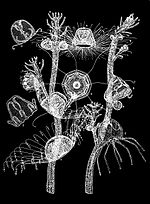In corals, the coenosarc is the living tissue overlying the stony skeletal material of the coral. It secretes the coenosteum, the layer of skeletal material... 1 KB (133 words) - 02:32, 22 April 2023 |
 | a sheet of living tissue, the coenosarc, which joins the polyps and anchors the colony to the substrate. The coenosarc may consist of a thin membrane... 39 KB (3,985 words) - 06:10, 12 January 2024 |
 | long as the colony is alive, the polyps and coenosarc deposit further calcium carbonate under the coenosarc, thus deepening the corallites. Each polyp... 4 KB (538 words) - 01:06, 7 November 2022 |
 | structures. The gonophores in the family Milleporidae arise from the coenosarc (the hollow living tubes of the upright branching individuals of a colony)... 13 KB (1,430 words) - 09:42, 28 April 2024 |
corals, the coenosteum is the stony skeletal material secreted by the coenosarc, the layer of living material lying between the corallites (the stony... 1 KB (136 words) - 23:32, 5 June 2019 |
 | colony showing branching pattern, magnification × 8. br. = branch, coen. = coenosarc, n.t.1/2/3/4 = new tubes enveloping a branch from a coenosarcal strand... 2 KB (69 words) - 17:23, 24 March 2024 |
 | gonophores in the family Solanderiidae, where known, arise directly from coenosarc (i.e. the hollow living tubes of the upright branching individuals of... 5 KB (591 words) - 18:30, 26 March 2023 |
 | coverage within the different regions of the colony and protects the coenosarc of the polypoid stage. It originates as epidermal secretions, with the... 15 KB (1,766 words) - 06:06, 22 April 2024 |
small stalked barnacle some 2 to 5 mm (0.1 to 0.2 in) in length. The coenosarc (living tissue) of the host coral sometimes grows over the surface of... 3 KB (329 words) - 22:32, 4 October 2021 |
 | layer of living tissue, the coenosarc. M. auretenra is unusual in this respect because, as the coral grows, the coenosarc progressively dies back on the... 7 KB (877 words) - 20:25, 17 June 2022 |
 | connected by a layer of translucent, jelly-like mesoglea tissue called coenosarc which covers the surface of the carbonate skeleton. During the day they... 5 KB (504 words) - 17:47, 23 April 2023 |
 | is called the hydrocalus, and it has two layers – the coenosarc and the perisarc. The coenosarc is the internal tube, containing the coelenteron, and... 15 KB (1,743 words) - 03:22, 1 May 2024 |
from botany. The solenia circulate nutrients throughout the coenenchyme. Coenosarc is an alternative name. Menzel, L.P.; Tondo, C.; Stein, B.; Bigger, C... 2 KB (185 words) - 01:10, 20 September 2023 |
 | dies. This has been termed "polyp bail-out" and involves growth of the coenosarc (the living tissue covering the skeleton) to isolate the polyp, detachment... 7 KB (894 words) - 06:01, 3 March 2024 |
of Hydroid and Bougainvillidae family starts as epidermal secretions. Coenosarc, which is the epithelial epidermal layer consists of various cell types... 5 KB (665 words) - 00:18, 3 December 2023 |
the polyp that sits inside it. New polyps grow on short stolons and the coenosarc (soft tissue) does not cover the skeleton in a continuous sheet as it... 4 KB (436 words) - 18:02, 15 March 2021 |










